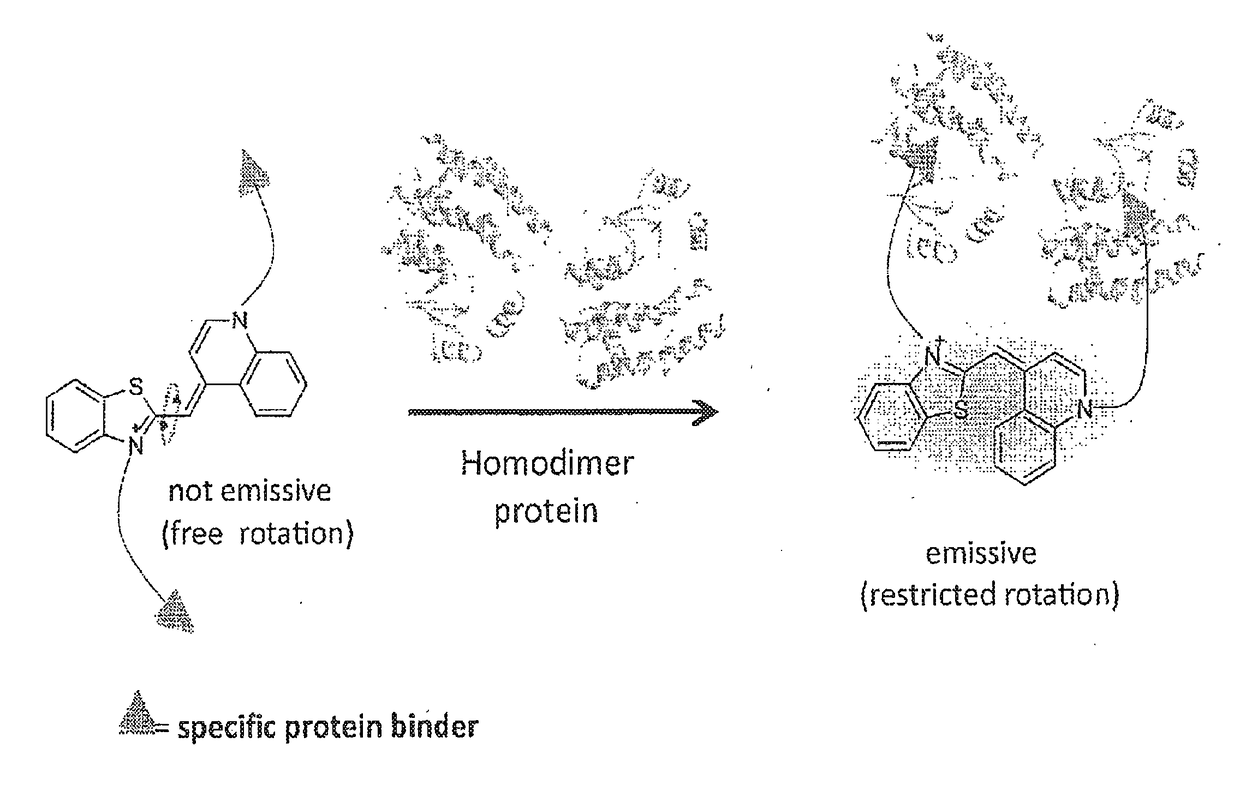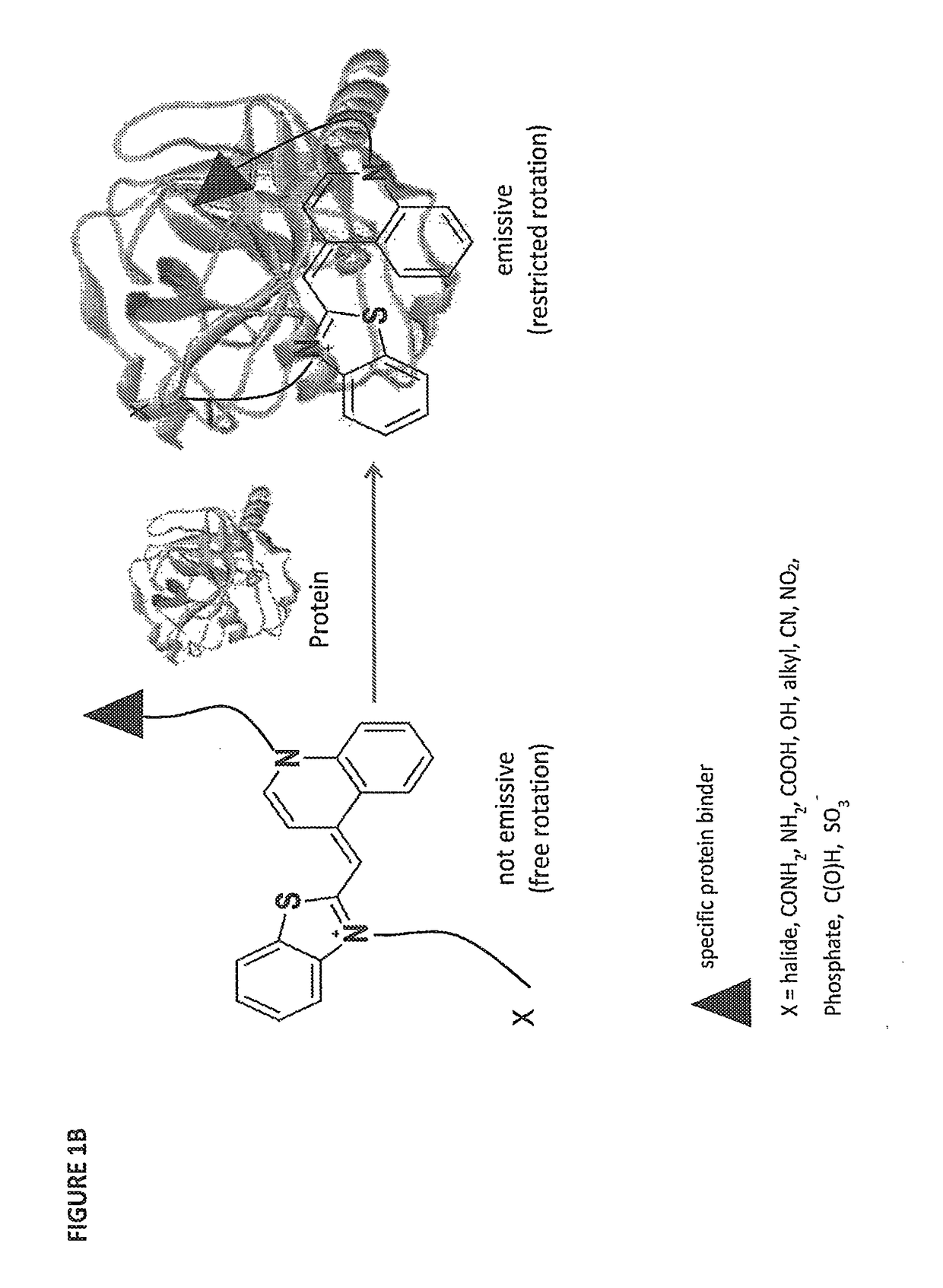Molecular sensor and methods of use thereof
a sensor and molecular technology, applied in the field of fluorescent molecular sensors, can solve the problems of difficult to obtain highly selective sensors, difficult to achieve high sensitivity, and difficult to develop fluorescent molecular switches that can recognize target proteins with high affinity, and achieve the effect of reducing fluorescent intensity
- Summary
- Abstract
- Description
- Claims
- Application Information
AI Technical Summary
Benefits of technology
Problems solved by technology
Method used
Image
Examples
example 1
Preparation of Thiazole Orange based Sensors (TOPI)
[0263]Thiazole Orange (TO) was selected as the signaling unit for the sensors of the invention because this asymmetrical cyanine dye exhibits remarkable ‘turn-on’ fluorescence response once the torsional motion between the benzothiazole and the quinoline rings in the excited-state is restricted, for example, upon binding to double-stranded DNA (FIG. 1C(a)). This property has been elegantly used to construct low-noise forced intercalation probes (FIT-probes) for sensitive detection of RNA and DNA. Other hybridization probes as well as aptamer- or antibody-based sensors further demonstrate the versatile use of this dye for sensing applications, and also indicate that fixating of TO in its fluorescent form does not necessarily require intercalation between DNA base pairs.
[0264]It was anticipated that modifying TO with two protein binders would result in a TO-based protein identifier (TOPI) that is inherently non-fluorescent in the unbo...
example 2
Synthesis of other TO based sensors [(34), (35), (36), (37), (20), (26), (33)]
A. Synthesis of Sensor (34) and (35) (FIG. 4)
3-(2-carboxyethyl)-2-methylbenzoidlthiazol-3-ium iodide (38)
[0294]2-methylbenzothiazole 1 (636 μL, 5 mmol) and 3-iodopropionic acid (2.29 g, 15 mmol) were mixed together under nitrogen. The mixture was stirred and heated at 110° C. overnight. The solid was suspended in methanol:Et2O solution (1:2, total 60 mL solution). The precipitate was filtered and washed with Et2O, then dried under reduced pressure to yield a white solid (1.2 g, 68%).
[0295]1H NMR (300 MHz, DMSO-d6): δ=2.98; (t, J=6 Hz, 2H), 3.26; (s, 3H), 4.89; (t, J=6 Hz, 2H), 7.77-7.91; (m, 2H), 8.35-8.46; (m, 2H), 12.73; (br-s, 1H), MS-EST (m / z): calcd. for C11H12NO2S [M-I] 222.05; found 221.96.
1-(2-earboxyethyl)quinolin-1-ium iodide (39)
[0296]3-iodopropionic acid (5.56 g, 27.9 mmol) was added to a solution of quinoline 4 (2.74 mL, 23.23 mmol) in 30 mL of dioxane. The solution was stirred under reflux fo...
example 3
Spectral Characterization of Thiazole Orange (TO) Derivatives (Sensor 14)
[0338]Different 10 derivatives (Table 3) were incubated with increasing concentrations of double-stranded DNA and compared their fluorescence emission prior to and after their incubation in PBS buffer, pH=6.5 (FIG. 9).
TABLE 3Structure of different TO derivativesTO derivativeXYZUnmodified OTs-TOdiol-modified TO,I-compound 6monoalkyne- modified TO (compound 27)I-dialkyne- modified TO, Compound 8I-ethacrynic acid- modified, Compound 14I-
[0339]In all cases enhanced fluorescence at 530 nm was observed. The addition of dsDNA induces a smaller increase in the emission of all derivatives. The molecular sensor 14, in particular, did not exhibit any change in its fluorescence at 530 nm upon addition of dsDNA. These findings can be attributed to steric effects, in which bulkier substituents hinder the free rotation of TO and, at the same time, disrupt the intercalation of the two heterocycles with dsDNA. In addition, only...
PUM
| Property | Measurement | Unit |
|---|---|---|
| Mass | aaaaa | aaaaa |
| Mass | aaaaa | aaaaa |
| Fluorescence | aaaaa | aaaaa |
Abstract
Description
Claims
Application Information
 Login to View More
Login to View More - R&D
- Intellectual Property
- Life Sciences
- Materials
- Tech Scout
- Unparalleled Data Quality
- Higher Quality Content
- 60% Fewer Hallucinations
Browse by: Latest US Patents, China's latest patents, Technical Efficacy Thesaurus, Application Domain, Technology Topic, Popular Technical Reports.
© 2025 PatSnap. All rights reserved.Legal|Privacy policy|Modern Slavery Act Transparency Statement|Sitemap|About US| Contact US: help@patsnap.com



